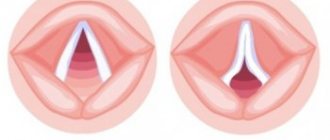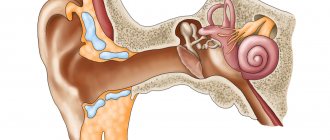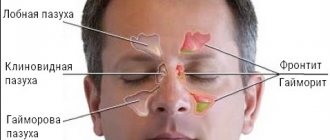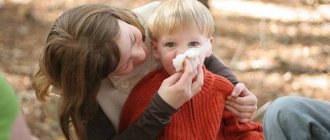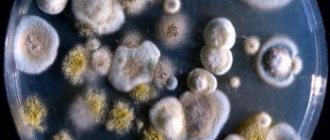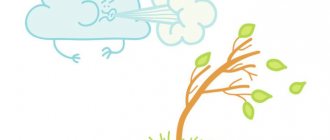Causes
The main factor in the development of the inflammatory process in the sinuses are microorganisms. These can be fungi or bacteria such as staphylococcus, which the body is not able to fight back. The causes of frontal sinusitis often lie in previous diseases that were not cured or partially eliminated:
- adenoids, polyps and abnormalities of the structure of the nose;
- viral diseases with swelling of the mucous membranes (ARVI, influenza);
- chronic diseases of the respiratory system;
- allergic reactions with attacks of asthma and vasomotor rhinitis;
- previous infections, such as diphtheria or scarlet fever;
- injuries.
The appearance of frontal sinusitis is often caused by disturbances in the human immune system and even such a banal, at first glance, reason as the inability to blow your nose correctly.
Symptoms
Signs of frontal sinusitis in middle-aged people differ depending on the form of the disease.
- Acute frontal sinusitis is characterized by a strong cough at night. When a purulent mass accumulates in the sinuses, painful headaches appear if you press on the frontal sinuses, turn and tilt your head. Sometimes the pain radiates to the ears or teeth. If you lie down, it becomes a little easier. Thick nasal discharge (both clear and purulent) has a pungent odor. The nose is stuffy and there is a lot of pressure. Chills, fever, and nasality are noted.
- Chronic frontal sinusitis in the first days of relapse resembles an acute respiratory infection: nasal congestion, secretion of mucus and pus, low-grade fever, malaise, pain in the bridge of the nose. There is no headache. After sleep, swelling of the eyelids and brow ridges is possible. Gradually, a person’s sense of smell decreases, he constantly feels weak, and coughs up phlegm in the morning. Conjunctivitis and polyps may develop.
Symptoms of sinusitis
Now let’s take a closer look at how to recognize frontal sinusitis in adults and children. This can be done using the following criteria:
- pain in the bridge of the nose;
- nasal congestion, problems with blowing your nose;
- increased body temperature (although some forms of frontal sinusitis occur without fever);
- general malaise (weakness, lethargy).
Based on the listed symptoms, it is clear that they can easily be confused with signs of a common acute respiratory infection. Therefore, to complete the picture, let’s look at this in more detail.
Acute form
Symptoms characteristic of acute frontal sinusitis are more pronounced:
- severe headaches, which are explained by the accumulation of pus in the affected sinuses. When a person takes a horizontal position, the pain may subside, because... purulent masses are evenly distributed throughout the sinuses;
- feeling of heaviness in the bridge of the nose. Outwardly, it is a strong tumor, the piercing pain in the nose and frontal part does not allow you to touch it. When tilting the head, dizziness may occur;
- increased intraocular pressure, which increases while reading or working on a computer. Often this is accompanied by throbbing pain in the back of the head and temples;
- viscous mucous discharge of a purulent nature with an unpleasant odor. The feeling of stuffiness persists, and it is impossible to blow your nose;
- a sharp jump in body temperature (more than 38 C);
- night cough caused by the contents of the nasal sinuses draining into the larynx;
- apathy, sleep disturbance, weakness and malaise.
In children, acute frontal sinusitis is more severe, because The child’s body has difficulty coping with the disease. In the acute form of the disease, the child’s condition worsens in a matter of hours, accompanied by nasal discharge, cough and fever.
Chronic form
Typical clinical manifestations of chronic sinusitis:
- decreased sense of smell;
- conjunctivitis;
- swelling of the eyelids and eyebrows;
- chronic cough at night;
- breathing problems;
- fast fatiguability.
These symptoms are also easier to identify because they appear in someone who has already had frontal sinusitis at least once.
Surgical method of getting rid of frontal sinusitis
Those who read the title and decided that it was about cutting the nose can rest easy. For frontal sinuses, a slightly different method is used - puncture of the purulent sinuses. This mini-operation is performed on very dense formations, so as not to provoke pressure on the membranes of the brain. The piercing is performed by an ENT doctor in a clinic under local anesthesia.
Treatment of frontal sinusitis without a puncture is also possible. But to do this, you cannot start the disease, but start taking measures immediately after making a diagnosis or identifying frontal sinusitis. Below we look at various non-surgical treatment options.
Classification of frontal sinusitis
Depending on the characteristics of the inflammatory process, two forms of the disease are distinguished.
Spicy
Pathogenic bacteria are very active in the sinuses and nasal cavity. The inflammatory process is constantly progressing, and the mucous membrane swells greatly. The illness lasts about a month.
Chronic
- If you do not cleanse the frontal sinuses, chronic inflammation begins. It is provoked by abnormalities of the nasal septum and incorrectly chosen treatment methods. The signs, as a rule, are somewhat erased and not expressed clearly enough. The disease can last up to 6 weeks.
- Chronic frontal sinusitis is often diagnosed using computed tomography. In the image of each layer you can see the localization of the process and the anatomical features of the nasopharynx. The procedure is carried out during the period of remission.
- If chronic sinusitis is not treated, inflammation will begin in other paranasal sinuses. Therefore, after making a diagnosis, specialists immediately prescribe antibacterial therapy. Treatment of chronic frontal sinusitis in adults is the use of drugs with penicillin.
- How long does it take? It usually takes patients about a month to forget about the chronic phase of frontal sinusitis.
By type of inflammation
Sinuses affected by sinusitis.
Based on the type of inflammation, there are two main categories of frontal sinusitis: exudative and productive. In the first, there are forms of purulent, serous and catarrhal sinusitis. This frontal sinusitis is characterized by the accumulation of fluids in the sinus area. For example, catarrhal sinusitis is an accumulation of only watery mucus. In this case, sharp pain in the forehead radiates to the upper jaw and eye sockets. Catarrhal frontal sinusitis is characterized by debilitating attacks that last from 10 - 12 to 3 - 4 o'clock in the afternoon.
As for the productive type, it is divided into polyposis and parietal hyperplastic. In this case, the tissues grow inside the sinuses and form growths.
By etiology
According to the etiology of the disease, bacterial, viral, allergic, fungal and mixed frontal sinusitis are distinguished. Each form has its own characteristics. Thus, viral frontal sinusitis is often a complication after ARVI, and fungal sinusitis affects the frontal sinuses in older people.
By localization
Depending on the area that is affected by the inflammatory process, unilateral and bilateral frontal sinusitis is distinguished. In the first case, it is a right-sided or left-sided type of disease. Bilateral frontal sinusitis is a parallel lesion of both sinuses in the forehead.
Frontitis treatment with folk remedies
1). Nasal rinsing.
Solution No. 1. For a mug of warm, after boiling water, you will need: ¼ part teaspoon of regular salt, 2 drops of tea tree oil (if unavailable, replaced with iodine) and a pinch of soda.
Solution No. 2. For a mug of pure boiling water you will need: 1 teaspoon each of healing chamomile flowers and healing herb St. John's wort. Infuse exclusively in a thermos for exactly 45 minutes, strain and let it cool on its own to the temperature of your room. The composition has a bactericidal effect.
Solution No. 3. For 500 ml of water use: exactly 2 tablets of furatsilin. This tablet is an excellent antiseptic against many bacteria.
Important information!!! Any of the solutions listed above and the solution you choose must be thoroughly filtered through a generous layer of gauze.
Correct washing technology.
1.) Any solution suitable for your treatment is collected in a special kettle, or even better, a special syringe.
2). Before rinsing, you need to completely blow your nose; if necessary, use special helping drops.
3). Bend over the bathtub (sink), turn your head correctly, hold your breath completely and run the medicinal solution into your nostril.
When everything is absolutely correct, then the entire medicinal composition, together with mucus, must come out from the opposite nostril. Any washing can be carried out no more than 4 times per day. Excellent for relieving headaches.
2).Nasal inhalations.
To defeat frontal sinusitis at home, you can use inhalations that help in treatment. If possible, purchase an ordinary special steam inhaler. If it is not possible to purchase it, then you can use regular inhalation.
Method No. 1. Well boil only 2 already completely peeled potatoes, then drain all the water, cut the potatoes into small pieces or crush them.
Method No. 2. Take 2 tbsp. l exclusively chamomile flowers, steam in a suitable saucepan with 2 cups of clean boiling water and add a couple of drops of eucalyptus oil.
Method No. 3. Grind exactly 4 cloves of garden garlic, add a glass of clean boiling water and 4 tbsp. l apple cider vinegar.
Method number 4. For 5 minutes, it is necessary to simmer 5-6 bay leaves on the lowest heat.
Method No. 5. Choose a small saucepan, fill it halfway with water, boil it and add some star balm.
All of the above methods have been used by many people. Any inhalation is done only when hot, bend completely over your container, inside which is the selected solution. Cover yourself with any suitable warm item or towel. The number of procedures should be no more than 3 times per day, lasting up to 15 minutes.
Important information!!! Self-inhalation at home is permitted and permitted in the absence of any body temperature, the absence of any purulent discharge and nosebleeds.
3). Warming the forehead.
If unfavorable frontal sinusitis occurs, treatment in adults with folk remedies can be carried out by warming the forehead. With this disease, many people feel some pressure in the forehead area. Warming is recommended to relieve discomfort and pressure.
The easiest and best way is to use 2 boiled chicken eggs. They store the heat for a long time, which is necessary for warming the forehead. Very hot eggs are wrapped in a suitable towel and immediately applied to the forehead, just above the eyebrows.
There is another surefire method that is as good as using chicken eggs. It is enough just to warm the sea salt well in a completely dry kitchen frying pan, wrap it in a suitable material or a simple handkerchief to produce warming.
Important information!!! Also, as with inhalations, such a procedure will be strictly contraindicated at any body temperature, discharge of pus from the sinuses, or nosebleeds.
Diagnostics
- The patient’s complaints at the doctor’s appointment play an important role. Typically, during examination, the specialist notes swelling near the nose and eyes. In addition, to make a diagnosis, it is important to determine the color and thickness of nasal discharge, the location of headaches and possible previous diseases. To detect the inflammatory process, the rhinoscopy method is used. It helps to identify pus, swelling and redness of the mucous membrane.
- An x-ray can show the condition of the frontal sinuses and the presence of fluid in them. X-rays help determine the type of frontal sinusitis, but a final diagnosis is not always made at this stage. An alternative method of analysis is ultrasound of the paranasal sinuses.
- The contents of the sinuses are tested in the laboratory for the type of pathogen and sensitivity to antibiotics. This allows you to determine the specific type of frontal sinusitis and choose the right course of treatment.
In children
- Rinsing the nose during sinusitis is an important procedure.
In children, the cause of the disease is often a foreign object entering the nose. - Children's bacterial frontal sinusitis is usually caused by microorganisms of the genus Moraxella. In this case, the disease occurs in a mild form.
- Diagnosis of an inflammatory process in the nose in children is not always painless. The safest and most effective method is ultrasound of the sinuses. Using this procedure, you can identify the cause of the disease, its shape and volume of mucus.
- Symptoms of frontal sinusitis in young children are more difficult to establish. Kids cannot always tell exactly where and what hurts them. In early childhood, unilateral frontal sinusitis is mainly observed. The main signs of illness are high fever, restless sleep, poor appetite, lethargy and problems breathing through the nose. Such signs often resemble a common cold, but gradually paleness of the face, swelling, cough in the morning and lacrimation are added to the picture of the disease.
- To treat frontal sinusitis in children, nasal drops and topical sprays are used, without side effects. Antimicrobial drugs help eliminate the source of infection. These can be Hexoral, Bioparox, which are used for no more than 7 days.
- If the cause of frontal sinusitis is associated with viruses or allergic factors, then children are prescribed antihistamines and decongestants, as well as physical therapy.
- Frontal sinusitis in childhood is rarely treated with strong antibiotics. Such drugs in large doses can damage the liver and stomach. This method, in the form of a course of injections or tablets, is applicable for children only in extreme cases.
- Improper treatment of a runny nose can lead to the development of chronic sinusitis and even inflammation of the middle ear.
Precautionary measures
When Cuckoo is prescribed for a complicated runny nose, special attention is paid to inhalation and warming. An integrated approach to the treatment of frontal sinusitis eliminates the need for a puncture. But only compliance with safety rules will allow you to avoid side effects.
Do not breathe directly over boiling water. It is necessary to prepare the solution and leave it covered with a lid for 5 minutes. It is especially dangerous to carry out steam inhalations in children. Before sitting the child over the container, it is necessary to keep the medicinal decoction without fire for 10-15 minutes.
Intensive cleansing of the nose can increase the effectiveness of treatment. For this purpose, rinsing is carried out with a saline solution or a decoction of medicinal herbs. After the procedure, they begin steam inhalation or work with a nebulizer. If breathing is very difficult, then use vasoconstrictor drops. Only after air circulation has been restored should inhalation begin.
The procedure is not done after eating. At least 2 hours must pass after eating before starting treatment.
You should not start inhalation if you are not sure that there are no contraindications. Only during an examination by a doctor can the presence of excessive swelling and suppuration be determined. These factors are the fundamental reasons for refusing thermal inhalation. Using a nebulizer and inhaling vapors from the juices of medicinal plants have virtually no contraindications. But you need to definitely exclude allergic reactions, which can aggravate the course of the disease and provoke severe swelling of the nasopharynx.
Side effects after the procedure occur in case of individual intolerance to medications used for inhalation. Immediately after warming up, it is necessary to direct efforts to maintain heat in the body. For this purpose, they exclude going outside, wrap themselves in a blanket and stay in bed for some time.
Frontitis during pregnancy
- In expectant mothers, frontal sinusitis can have several degrees of severity. A mild form of the disease during pregnancy is usually caused by viral infections and is manifested by a runny nose. The average degree is characterized by the presence of pus and signs of intoxication, high temperature. Severe frontal sinusitis is associated with impaired hearing, vision and severe pain.
- Diagnosis of frontal sinusitis using x-rays is prohibited for pregnant women. They are sent for diaphanography - surface laser scanning.
- Frontal sinusitis during pregnancy is also dangerous for the unborn child. The woman provides oxygen not only to herself, but also to the baby, so that difficulty breathing causes fetal hypoxia.
- Swelling of the nose during illness is relieved with vasoconstrictors. They are chosen together with a doctor so that there is no impact on the placenta. Sea salt drops are especially recommended.
- Sinus piercing helps a lot during pregnancy. It allows you to pump out the pus and introduce medicine into the cavity. Sometimes the puncture needs to be done several times, but most often expectant mothers only need one appointment with a doctor.
- Drugs containing adrenaline or ephedrine are prohibited for pregnant women. It is better to choose products such as Sinupret in the form of drops rather than tablets, and not to use them during lactation.
Additional information: all types of sinusitis during pregnancy.
Use of antibiotics
There are several types of antibiotics that can be prescribed for the treatment of frontal sinusitis:
- Most often, synthetic or semi-synthetic penicillin drugs are prescribed for frontal sinusitis. The most popular drugs in this category are Ampisid, Amoxicillin, Amoxilav.
- Cephalosporin drugs have a similar molecular structure to the previous group. Drugs such as Cefaclor or Cefotaxime help get rid of even severe forms of frontal sinusitis. It is best to give injections, but remember about possible side effects - disruption of the intestinal microflora.
- Macrolide drugs are prescribed if intolerance to penicillin is detected or other antibiotics do not help. Drugs like Sumamed and Azithromycin are especially good because they do not affect the intestines and at the same time relieve inflammation by killing bacteria in the cells.
Each of the selected drugs has its own individual characteristics. However, the forms of frontal sinusitis and the age of the patient also influence the use of such drugs.
- The indication for taking antibiotics is usually purulent discharge, which indicates the presence of bacteria in the sinuses. Your doctor may also prescribe medications to relieve migraines and nasal pain. Remember that viral or allergic sinus inflammation cannot be treated with antibiotics. This is ineffective and also causes a decrease in immunity and dysbacteriosis.
- In adults, antibacterial therapy in the presence of frontal sinusitis has two main forms. Tablets or injections are used when using general remedies. The local effect of antibiotics is achieved by administering sprays and drops.
- Antibiotics for frontal sinusitis are prescribed in accordance with the causative agent of the disease. Thus, pneumococci are often destroyed with tetracycline agents. If Haemophilus influenzae is present, Amoxilav or Ampiox is prescribed.
- Acute frontal sinusitis helps to relieve Sumamed, which has a wide spectrum of action. In case of attacks of acute frontal sinusitis in children, Ceftriaxone is prescribed (if there is no intolerance). Among the drugs in the tetracycline and macrolide groups, Erythromycin or Azithromycin are indicated for children.
- The doctor must indicate to the patient how long the antibiotic therapy will take. In adults, the course of treatment may take 10 days, unless frontal sinusitis is chronic.
About traditional treatment
Home medicine methods occupy a significant place in the life of every person. The experience of generations has proven the high effectiveness of many methods of self-medication using natural ingredients. Such therapy not only eliminates all unpleasant symptoms, but also affects the treatment process.
But it is worth remembering that traditional medicine is not alternative and can only be used in combination with the treatment prescribed by your doctor.
Treatment of frontal sinusitis with folk remedies becomes possible only if the disease has become chronic. If the disease is diagnosed in its acute manifestation, then therapy should consist of the use of medications and other drugs prescribed by your attending physician.
If the acute form of the disease is not treated or left untreated, then over time it will transform into a chronic one. In such a situation, you can use home methods.
The disease will periodically worsen, and exacerbations can overtake the patient suddenly. The use of simple but effective home recipes can help people eliminate unpleasant symptoms and alleviate the condition.
A course of treatment
Symptoms and treatment of frontal sinusitis are closely related. Therefore, depending on the signs of the disease, the type of therapy is selected. For example, to speed up the drainage of pus and defeat bacteria, ointments such as Levomekol are used.
Pills
Among the popular drugs for illness, antihistamines, in the form of tablets, are: Diphenhydramine, Tavegil, Suprastin. You can take them 1 tablet 3 times a day, and they will reduce swelling and eliminate an allergic reaction (the dose is approximate, consult a doctor). Among the tablets to reduce the viscosity of secretions, Sinupret is most often prescribed. However, it should not be prescribed to small children and patients with liver pathologies.
Drops
Nasal drops during illness, aerosols and sprays help narrow blood vessels and relieve swelling, and many drops have anti-inflammatory and antibacterial effects. The use of products such as Fliconase and Nasonex helps to thin the mucus in the frontal sinuses. The most popular drops that relieve nasal congestion and improve breathing are Naphthyzin, Galazolin, Nazivin. Please note that any topical sprays or drops should not be used for more than a week.
- Knowing how to treat frontal sinusitis with antibiotics, it is important not to forget about the intestinal microflora. To increase immunity and to avoid consequences, patients are prescribed probiotics such as Linex and prescribed antihistamines.
- Inhalation treatments speed up the treatment process well. They require a systematic approach, so you will have to carry out procedures 3-4 times a day until all symptoms go away. So, it is possible to treat frontal sinusitis with the help of steam from hot potatoes in their jackets. It is also recommended to inhale vapors of eucalyptus oil with chamomile infusion.
- You should rinse your nose with a solution of salt, especially sea salt, which you can buy at the pharmacy. You can also cure sinuses using onions and honey. The onion should be grated and pour boiling water in which a spoonful of honey is dissolved.
- If you want to cure frontal sinusitis in the shortest possible time, for example, two days, you can use folk remedies. At home, inhalation with bay leaves helps a lot. Just boil water with them and, covered with a towel, breathe through your nose over the pan for about five minutes. The procedure frees the sinuses from pus and speeds up the fight against viruses.
- In two days, complete treatment of frontal sinusitis can be achieved with the help of massage. Daily rubbing of the limbs strengthens the body's defenses. Massaging with gentle pressure will help increase blood flow in the sinuses. You also need to knead the area of the nasal periosteum.
Is it possible to warm the body
When treating frontal sinusitis at home, some people prefer to warm their forehead. In fact, this is strictly prohibited.
- Warming the frontal sinus means artificially increasing the temperature in the tissues. This effect contributes to the development of purulent formations in nearby areas. It will be very difficult to remove pus from this part of the face.
- Some forms of frontal sinusitis from thermal procedures only expand the list of their symptoms. If you heat your forehead, you can get severe swelling and a new influx of painful bacteria.
- If you do not want to give up such folk remedies, you can warm only the bridge of the nose with an egg or sand.
Operation
Surgical intervention for frontal sinusitis is possible in different forms.
- External transfrontal operations. This includes trephination of the anterior wall of the sinus (Ogston-Luke procedure) and complete resection of the walls of the sinus and brow ridges (Kunth procedure). The first option is considered more preferable because it opens the frontal sinus well and leaves minor cosmetic defects. This procedure cannot be performed before the age of 14. The Kunta operation, in turn, is characterized as traumatic and is used extremely rarely today.
- Transnasal surgery. This includes a technique such as removal of the bone mass with the insertion of a probe (Galle-Vacche-Denis operation). This procedure is not popular due to technical features. Not all specialists can operate in a narrow endonasal space.
- External transorbital surgery. This class involves trephination of the lower wall of the sinus according to Jansen-Jacques. Also included in this category is the opening of the frontal sinus according to Belogolov. The operation differs from the Halle procedure only in the external front of the work, and therefore the visibility of small sinuses and their accessibility increases. This is a gentle procedure that helps avoid trephination of the bone walls.
- Separate from these categories is Killian's operation. It was developed in the 20th century and allows you to open all the cells in the sinus to remove tissue. Fronto-orbital trepanation of the frontal sinus occurs while preserving the septum - the so-called bone bridge. This operation is often performed for facial bruises and injuries to the cranial bones.
Traditional methods against frontal sinusitis
Most often, people are interested in treating frontal sinusitis with folk remedies at home, because many do not have time to go to clinics. Therefore, let's look at a few simple recipes using products and items that everyone definitely has at home.
- Bay leaf. Throw a few leaves into boiling water, simmer for 10 minutes, and then breathe over the steam. Perform the procedure in the morning, and in the evening you can leave the same decoction, warm it up and breathe again.
- Garlic. Grate half the head (several cloves), pour half a glass of boiling water and add the same amount of apple cider vinegar. Do inhalations twice a day.
- Potato. Boil several potatoes in their skins, mash them without removing the skin. Breathe over this puree, covered with a towel.
- Kalanchoe. Keep a few leaves plucked from the bottom of the stem in the refrigerator for 2 days. Then squeeze the juice out of them and mix with boiled water in equal proportions. Pipette a couple of drops into the nostrils 3 times a day.
- River sand. Heat a handful of sand in a frying pan, pour it into a cotton bag and apply it to the bridge of the nose. You can use a boiled egg in the same way.
Many people are interested in whether it is possible to warm the forehead during frontal sinusitis? Answer: absolutely not. Because an artificial increase in temperature in the tissues will cause purulent formations to spread into nearby tissues. Removing pus from the frontal part of the face is very difficult, so only the area of the bridge of the nose should be heated with sand or egg.
Treatment of frontal sinusitis with folk remedies helped people even before the invention of medicines. Therefore, today the recipes remain popular and effective. You don’t need to use everything at once: choose the most suitable method for yourself and use it for 3-4 days. If there is no improvement, then switch to another method.
Complications
Frontal sinusitis is a disease whose complications can actually threaten life. The transfer of purulent contents to the brain and nearby tissues is especially dangerous. The consequences of frontal sinusitis are usually divided into orbital and intracranial.
- Orbital complications are associated with the transition of infection and inflammation to the orbit. In this case, orbital abscesses, periostitis, and osteomyelitis may be observed. Orbital phlegmon is especially dangerous, which not only threatens vision loss, but also death.
- Intracranial complications involve movement of the source of infection into the cranial cavity. These are abscesses of the subdural and epidural types, meningitis and sepsis. In the latter case, a variety of systems in the body are affected.
Disease prevention
To prevent the occurrence of diseases and the development of complications, you need to follow simple tips:
- Watch your diet and avoid hypothermia.
- Start treatment measures when the first symptoms of the disease appear.
- Avoid stress.
- Organize your work and rest schedule correctly.
- Eliminate foci of chronic infections in the body in a timely manner.
- Use humidifiers to avoid dry mucous membranes in the upper nasal passages.
- This advice is especially relevant for the heating season.
- Lead a healthy lifestyle.
In order to avoid such an unpleasant procedure as sinus puncture during treatment for sinusitis and sinusitis, it is necessary to undergo therapy only under the supervision of a doctor. Even if the patient is an ardent fan of traditional medicine, all measures must be coordinated with a knowledgeable specialist. Only a person with a higher medical education can determine the degree of development of the pathological process and assess the risk of complications. Your health is in your hands.
Where to go? ENT clinics in Moscow:
Medical center Family clinic on Ilyich Square Moscow, st. Sergius of Radonezhsky, 5/2, building 1 Clinical Hospital on Yauza, st. Volochaevskaya, 15 Moscow, st. Volochaevskaya, 15, building 1 Hadassah Medical Skolkovo Moscow, Bolshoy Boulevard, 46, building 1 Yaroslavtseva Galina Nikolaevna Moscow, st. Novaya Basmannaya, 14 building 4 office 216 Medical center Family clinic at the River Station Moscow, st. Festivalnaya, 4 Children's clinic of the European Medical Center Moscow, st. Trifonovskaya, 26 All ENT clinics in Moscow on the map
Prevention
- In order for the immune system to be in good condition and defeat bacteria, you need to take vitamins and organize water hardening procedures.
- Prevention of frontal sinusitis is also associated with timely treatment of common colds. It is necessary to get rid of the first signs of a runny nose during allergies and flu as quickly as possible.
- Mild inflammation of the nose should be eliminated immediately by rinsing. Sanitary resort treatment on the sea coast helps a lot, especially if the vacation spot is surrounded by coniferous forest.
Conclusion
Frontitis is a form of inflammation of the frontal sinuses to the left and right of the nose. The disease varies according to the type of secretion, pathogens, stages of progression and area of damage. Thus, chronic and acute frontal sinusitis, right-sided and left-sided types of the disease are distinguished. The main symptoms are severe pain and nasal congestion. Frontal sinusitis is eliminated with the help of antibiotics, but gentle remedies are prescribed for pregnant women and children. The age of the patient also determines how long the treatment lasts. In cases of dangerous complications, surgery is performed on the frontal sinuses.


